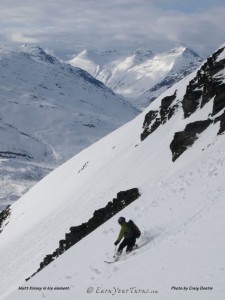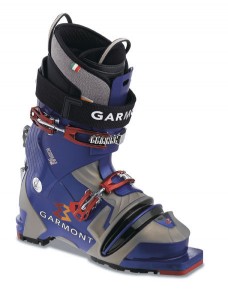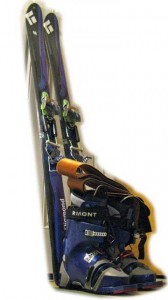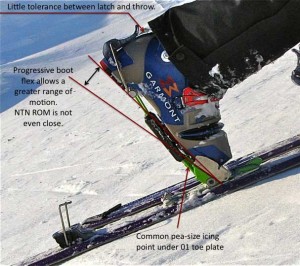Telemark equipment has gotten ridiculously heavy. Like many telemark skiers I kept adding more so I could enjoy unlimited terrain options; burlier boots, fatter skis, wider skins and heavier, more powerful bindings. Before long I was hauling over 10 pounds per foot into the wilds. Since 1990, the weight on our telemark feet has nearly doubled. I slogged my way back to the trailhead at the end of last season and finally hollered, “Enough is enough!”
I retreated to focus on cutting weight, lots of it. I had tasted the ultimate in telemark power with BD’s PUSH but the weight, bulk and multiple adjustments were too much drag in any condition. After having skied four years on two versions of BD’s Verdict as my one ski quiver, it seemed I had found the perfect dimensions for a backcountry ski. Too much fat can be as compromising as too much weight and thus limit a skis ability to handle a variety of conditions. This combination of boots and ski were just a bit too much rolling over flats or spending part of a day kick-turning through steep, thick brush to get to an untracked couloir. Breaking trail through deep snow seemed much less satisfying than years ago on T2X’s and those lovely BD Havocs. Faster, lighter, gear becomes an inevitable goal as your backcountry days increase.
Dynafit systems prove that simplicity, durability and strength are possible without requiring excess weight. Their latest tech binding weighs only 14.1 ounces (400 grams). That’s incredible. There is a need for the same “tech” innovation in telemark bindings. It can be done. Telemark skiers have plenty to be optimistic about in regards to the weight game. New metal alloys and plastic composites promise a new generation of offerings that should keep interest in telemark skiing high.
BOOTS: GARMONT KENAI
My “enough” moment resulted in taking a look at boots first. My last pair of boots bought me bigger quads but less vertical. I could ski most conditions fine but not with much finesse. The weight had me trudging as I skinned and strained while skiing downhill. When I was fresh they skied great. When I fatigued they skied poorly. The clunky feeling of multiple boot flaps, four buckles and a strap was just too much during the transition to ski mode with freezing bare fingertips. Craig Dostie’s review of the Garmont Kenai sparked my attention. Garmont seems to have found the sweet spots with two well-placed buckles on this workhorse telemark boot. So far, the boot has skied like a dream, nicely driving Black Diamond Drifts with BD O1 bindings.
I found a pair of Kenai’s at Alaska Mountaineering and Hiking this past October. Their boot-fitter was able to provide a custom fit of the liner that felt like he was performing surgery. The custom fit is a major factor in my positive review of the boot.
My feet have felt great touring. The factory liners fit like silk and my toes are very happy in the snow. Warmth is critical when wading through January’s arctic-like powder in Thompson Pass. I have tested them to 10F and my feet have stayed warm using thin socks. Adding a thicker sock could boost the comfort range -10F. My feet never got cold riding the lift all day.
The Good:
The Bad:
SKI: BLACK DIAMOND DRIFT
 The BD Drift jumped at me at the Pro Guiding Service in North Bend, WA last August. My one-ski quiver history demonstrates that the right pair of skis simply falls into my lap by chance. I thumbed through other latest BD offerings in the store looking for a particular profile I liked for the Chugach. The Drift tail design looked retro but I thought “why not”.
The BD Drift jumped at me at the Pro Guiding Service in North Bend, WA last August. My one-ski quiver history demonstrates that the right pair of skis simply falls into my lap by chance. I thumbed through other latest BD offerings in the store looking for a particular profile I liked for the Chugach. The Drift tail design looked retro but I thought “why not”.
Twice I peered at the weight shown on the sticker and wondered if it was a mistake.
“Those just arrived last Monday” the salesman sounded. “Rocker I think”.
I yanked on the tips with one hand, raising my eyebrows and noticing everything about the edges. Within hours of my new skis arrival at my doorstep in late October I was kneeling over them in the living room mounting the bindings. After twenty days of skiing in conditions ranging from powder to hard wind slab, the Drifts performed better each day. Hesitancy disappeared and my confidence increased recognizing the potential for light telemark gear in big mountain terrain.I weigh 165 pounds and carry an additional 20 pounds on my back. Much like the Havoc from years ago, I was more excited about this ski after testing them in a full range of conditions. My backcountry powder experiences over the past month can only be rated as amazing, so I am not going to “essay” about that. The ski was flawless in powder.
The 130cm in the tip is plenty. Anymore would simply amount to carrying P-Tex as training weight. The 100cm under foot is adequate to let lighter boots ski most conditions, and yet still provide the ultimate powder-hunting ski machine. There are many telemark skiers better than I and they will take this ski to amazing places.
One key concern is chatter on hard surfaces and I wanted to retain a one-ski quiver. Finding the ski that is fantastic in powder yet holds an edge on hard pack is not easy. Lack of edge control tempers stoke, and causes thigh fatigue. The risk of losing one’s edge in complex terrain can have serious consequences. I took the Drifts out for a full day lift skiing at Alyeska Resort in Girdwood, Alaska on ice-spotted groomers with some chunked-up off groomer and experienced no chatter. This is due in large part to the rocker design and a wood core that dampens edge noise. Part of my time at the resort was spent doing alpine turns between sessions of telemark bashing the roughs. The rocker design absorbs and dissipates the resistance of the metal edge on hard snow. I have no doubt that the lack of chatter was a major factor in allowing me more vertical at Alyeska in a day than ever before.
The rocker ski tip rises and falls over surface flaws more softly and quickly. The ski offers a great powder flex along with smooth control in all mountain conditions. In powder was I able to take off at full speeds doing wide GS type turns without hesitation. It’s nice to fly with light, fat skis while maintaining superior stability.
It is not uncommon on a long ski approach or exit to the trailhead to work terrain without skins on. Traveling over long slippery traverses and side hills can put you in better position to get first tracks. The lighter skis enable one to scamper across these challenges without fatiguing. The rocker enhances all aspect of trail breaking by glancing off impediments under the snow while you are breaking trail. Kick-turns can get exhausting on steep slopes, but the rocker just bends with the snow on impact making it easier to swing your tips around for the next uphill traverse.
Conclusion? Light is good.
A spec such as 135-100-125 for a backcountry ski is an excellent starting point. Don’t go beyond 140 in the tips for a one-ski quiver. The lighter AT skis seems to lack enough width in the tips and tails. Of course adding too much more fat adds more excessive weight thus giving you less versatility and more fatigue. It also adds more skin. The Drift looks like it will be my only ski for the next season.
BINDINGS: Black Diamond O1 – Ridiculously Stiff
Black Diamond has always supported my backcountry efforts. I will continue to punish the bombproof O1 and retire them at exactly 121.8 days as the pivot point begins to loosen on schedule and grass begins growing from the pipe tape on the cartridge threads. Black Diamond is due for another telemark binding series beyond the O1 and it is worth waiting for while skiing duckbills or whatever comes next with modifications to the NTN system (v8.2?).
I have looked seriously at the NTN system and saw nothing but an attempt to drag telemark skiing deeper in to weight gain and complexity. The NTN looked like the Marker Duke of telemark bindings. I was rebuilding my set up to lose, not gain weight. The free pivot range of motion (ROM) of the NTN leaves a lot to be desired in comparison to the O1. (This is highlighted in the adjacent picture which shows much better ROM in the BD O1, critical for clearing kick turns in steep terrain. The incremental improvements to gain additional control at this point in my 30-year telemark life did not seem worth the added weight of heavier boots and bindings. I yearned instead for freedom from the heavy lifting and more energy for the ski down.
I could shave a few more grams by going with the Voile Switchback, but am more comfortable with the cable under foot. To compensate for a possible loss in boot rigidity in a lighter designed boot, I replaced my older Medium Stiff cartridges with the Ridiculous Stiff. This strengthened duckbill/binding interface and gave me smooth telemarking with easier control for alpine turns when desired.
A final observation about telemark bindings: The most innovative change to telemark backcountry skiing over the past twenty years has been the free pivot binding. Its renovation is so simple and logical, that we as collective freeheelers should be chided for our “duh decades” of free pivot blindness. AT skiers were correct in their opinion that we needed to “figure it out”. Thus we must do the same with our binding flaws. We still need a lighter, high performance releasable telemark binding.
Conclusion:
Telemark is closing the weight and efficiency gap with AT. Hopefully a vaild weight comparison can be made of all the disciplines including snowboarders. Clearly the pendulum is beginning to swing toward a lighter, stronger and more versatile telemark set-up that will allow us to keep up with other backcountry disciplines in the pursuit of clean lines sharing fresh air as our fuel.
Here’s a look the weight of my rigs last year, and this year. That’s a solid 3 pounds of difference, or 1½ lbs. per foot.

If a pound on your foot is like five on your back, I saved myself the energy required to haul 15 pounds up the hill. The only way to save more weight would be to use a smaller ski, or go AT and lock the heel with Dynafit. I still like tele too much to do that.
Matt Kinney, aka Valdez Telehead, has “skinned” his way throughout Thompson Pass and the Valdez mountains for over 30 years. In 2006 he published Alaska Backcountry Skiing: Valdez and Thompson Pass. He guides clients throughout the area and has established a solid reputation as an earn your turns only guide. More on VT here.





11 comments
Skip to comment form
VT – you’re right on target. I have been thinking of throwing in the towel and switching to AT. Some of my friends are saying “No way” at this because I was a huge tele promoter. But I don’t feel like I’ve left telemarking, I feel like it has left me. NTN as you’ve pointed out stinks. Personally, I’ve gone the Voile Switchback route. Great binder. No trouble in several seasons and lighter than the BD pivot model.
You’d think with the dynafit patent open to all someone would figure out a way to use the toe piece and another binder under the forefoot. Let’s ask Craig – what ever happened to the Dostinator that was intriguing the BC blog circuit a couple years ago? Dostie are you listening…?
re: Dostinator
Am I listening? Ha!
Am I talking? Not yet, but things continue to brew. The good news is that the Dostinator appears to have passed the most critical test of releaseability. Not so much that it releases, but that it doesn’t release prematurely. That was an important feature to test and it appears to have done so with flying colors. But the proto had another weakness so now it’s time for round two. There are already 3 iterations in my head, but mum’s the word for the moment.
As for truely saving weight in tele, it’s easy if you downsize your rig and improve your technique. Agree that Switchback is all the binding you need if you can keep the waist width of your skis below 90mm. 😉
How do I get on the Dostie beta testing program? Happy to go hard on the binder in the Canadian Rockies and Rogers Pass…
Good luck Craig. Hope you can bring some sanity back and fight the tele-porker trend. Until then I’ll keep working the Havocs and switchbacks.
Best,
Joe
Am mulling over how to best do a beta program. IFF that happens you’ll definitely hear about it.
Nice work on lightening the load Matt, but aren’t the numbers in the two columns switched?
Good catch there Pete. That was my bad, not Matt’s. It has been corrected.
I share your frustration with heavy tele equipment, but have gone another route to relieve the frustration.
Madshus Glittertind ski
Salomon XA8 boot
Salomon XA Automatic binding
Total weight is 2.3 kg
Touring ability is unmatchable with any other tele or AT outfit.
The skis and boots are capable of skiing difficult backcountry conditions well. They are at their weakest in really deep snow (18 inches +), which is probably not uncommon for you (and for me, too, here near Mt. Baker), but are perfectly ok in moderate depth powder or other soft snow. They can handle breakable crust, stiff snow, wet, deep snow, and hard snow well. Not as good in ski area like conditions of broken fresh snow or variable crud.
Safety is good because of the always on touring pivot and the relatively soft boots.
Technique is not the same as with fat skis, but there are solutions to most skiing problems.
Sorry, I left out the boots. Should be Glittertinds + XA8s + XA auto bindings + skins = 4.7kg = 10.3lb.
That seems more real.
Good points, but Glittertind is too much of a cross country ski for my taste. I’ve mounted Rottefella 3-pins on a pair of Tua Heliums. They are 97/73/87 mm and weigh 1130grams per ski.
With Asolo Morgedal or Snowpine/Snowfield the total weight should be around 2.5kg or 5 pounds per foot. Asolo Extreme or Scarpa Wasatch will add 300grams per foot, but also more support.
Author
I pulled the laces out of the boot liners a few days ago, eliminating that hassle (and weight!).
I replaced the old Drifts with the new camo colored Drifts. Replaced the liners in the Kenai with Intuition Pro-tours. I went with “new” 01’s with the green heel throw and an extra hole to drill.
Have close to 300 days on the reviewed set up. I replaced the bindings once. Love the 100 under foot on a light weight ski and rocker tip for trail busting, as the tip just won’t sink. The Kenai boots have done some billy-goating, bushwhacking, water wading, icy crap, steep powder and miles long approaches and are still are in good shape, so I’ll ski then another season.
I get to recycle the skins.
Got a month on the upgrades and still grinning, though I wish we had less flat light.
Why mess with a good thing. Tele on.